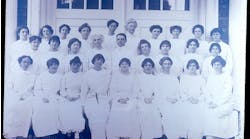by Anne Nugent Guignon, RDH, MPH
[email protected]
My maternal grandfather was in the newspaper business. He wrote a daily column for the Kansas City Journal Post and book reviews for the newspaper. Floor-to-ceiling bookshelves, crammed with books of all sizes, lined nearly every wall on the first floor of his house. The smell of paper permeated the air. Fifty years ago, the average person's primary information sources were limited to newspapers, books, magazines, radio, telephone, and a new technology, television.
Today's information is beamed via satellites, transferred through fiber-optic cables, and downloaded to smart phones and computers at a rate that is both exciting and frustrating. It's hard to keep up. New information can pop up at any time that will alter or enrich one's thoughts on thousands of topics.
Less than one week before last summer's RDH Under One Roof conference, new scientific information about biofilm-based chronic disease crossed my path. A month later, many of the brightest minds came forth with concepts that will alter the way we look at the caries process. In both cases it was a scramble to reformat my presentation and an upcoming webinar. Despite the stress of making last minute changes, it was important to share the news.
It's impossible to discuss every detail in a one-page column, but here are some highlights. Some thoughts will seem obvious, and others will take your thinking down a new path that will require adjustments in patient care.
The familiar call of biofilms
Biofilms are complex communities composed of hundreds of diverse microorganisms encased in a slimy matrix that is extraordinarily resistant to antimicrobials. Persister cells, which are multi-drug-resistant microbes, can be either bacterial or fungal. Persisters are typically dormant and are capable of surviving an attack from the most aggressive biocidal agents. Lingering persister cells allow biofilms to regrow. Persisters are implicated as the source of infections that recur even after conventional treatment.
Randall Wolcott, MD, a chronic wound specialist, speculates that different species of nonpathogenic bacteria form symbiotic relationships within a biofilm, resulting in behaviors that mimic the activities of well-known disease producing organisms. This phenomenon, called functional equivalent pathogroups, can contribute to chronic biofilm infections found in persistent, nonhealing wounds.
Many in the medical community now use a combination of therapies to treat biofilm-based infections. Treatments include thorough and regular debridement. Ultrasonics/ultrasound, conventional sharp debridement, or a series of both to provide mechanical disruption. Chemicals such as xylitol, lactoferrin, other chelates, and enzymes are used to break up the biofilm matrix, inhibit the formation of microbial communities, or interfere with surface adherence. Some treatments add ozone and hyperbaric oxygen therapy to defeat the anaerobic organisms. This mix of treatments sounds eerily familiar, doesn't it? In periodontal therapy, we're treating a biofilm-based chronic inflammation that we often describe as a wound.
A new strategy for caries
Caries researchers now know that there are many more players in the process than previously thought. For years, S. mutans and S. sobrinus were thought to be the chief acid-producing culprits, with some help from Lactobacillus. Recent studies demonstrate the plaque microbes differ between tooth surfaces as well as between primary and permanent teeth. Research has also shown that 10 to 20% of those with rampant caries in permanent teeth do not have detectable levels of S. mutans but instead exhibit other acid-producing bacterial species.
Scientists now believe dozens of other organisms, many of which have not been identified, may play an important role in the caries process. Bacteria responsible for early caries initiation are different from those found in established caries. In addition, some species of beneficial bacteria can adapt to living in a low pH. Faced with an altered environment, these bacteria now produce more acid, an adaptive response reminiscent of organisms in wound-based biofilm.
Each of these findings makes targeting specific bacteria in the caries process problematical and difficult. Current research suggests that caries is actually a pH-based disease rather than a process caused by a few specific species of bacteria. In that light, the focus needs to shift to other strategies which include increasing oral pH levels above the critical point of 5.5, introducing acid-neutralizing chemistries, improving salivary flow rates, finding ways to make tooth structure more acid resistant, improving the effectiveness of remineralization therapies, and helping patients understand the risk posed by frequent dietary intakes of highly acidic foods and beverages.
Are the books, magazines, and CDs on your bookshelf gathering dust or piling up faster than you can read? Getting current with new information about biofilms, caries, and fabulous new products is a great way to get out of your comfort zone and explore new ideas.
About the Author
Anne Nugent Guignon, RDH, MPH, is the senior consulting editor for RDH magazine. She is an international speaker who has published numerous articles and authored several textbook chapters, as well as presented seminars. She is a recipient of the 2004 Mentor of the Year Award and the 2009 Irene Newman Award and has practiced dental hygiene in Houston since 1971.





